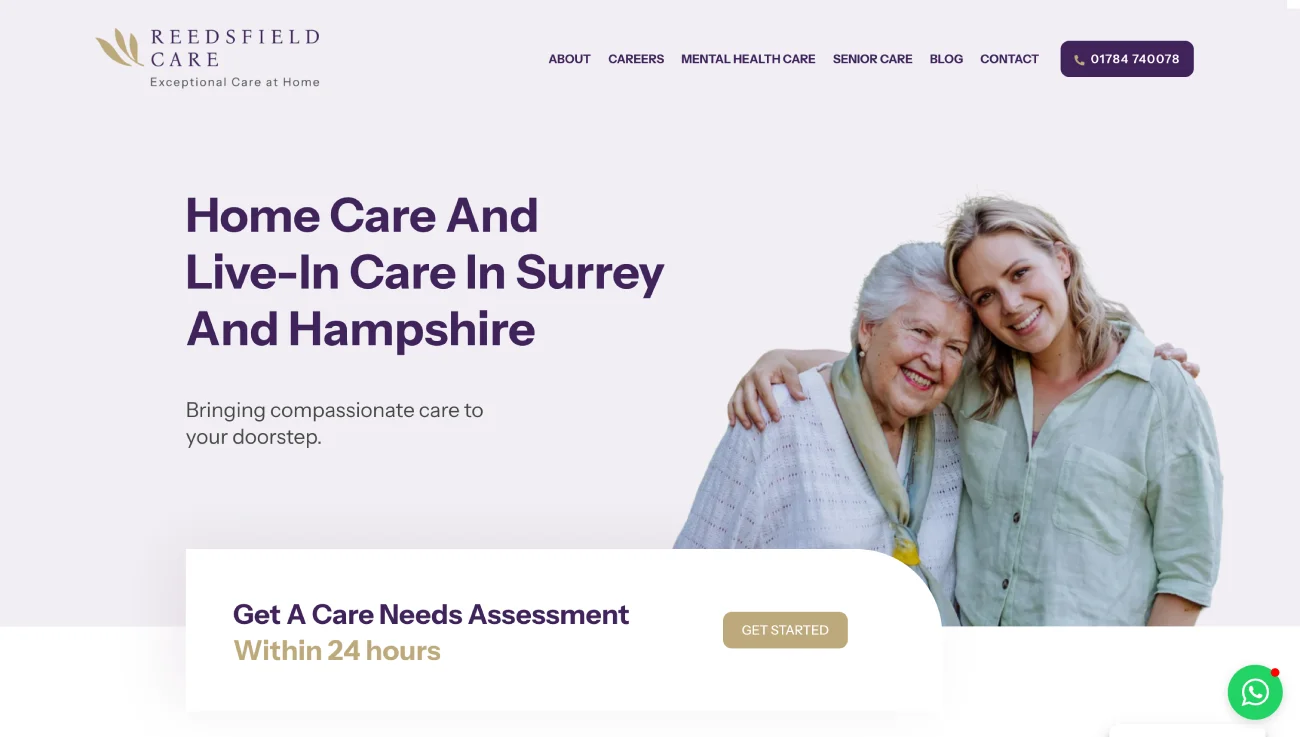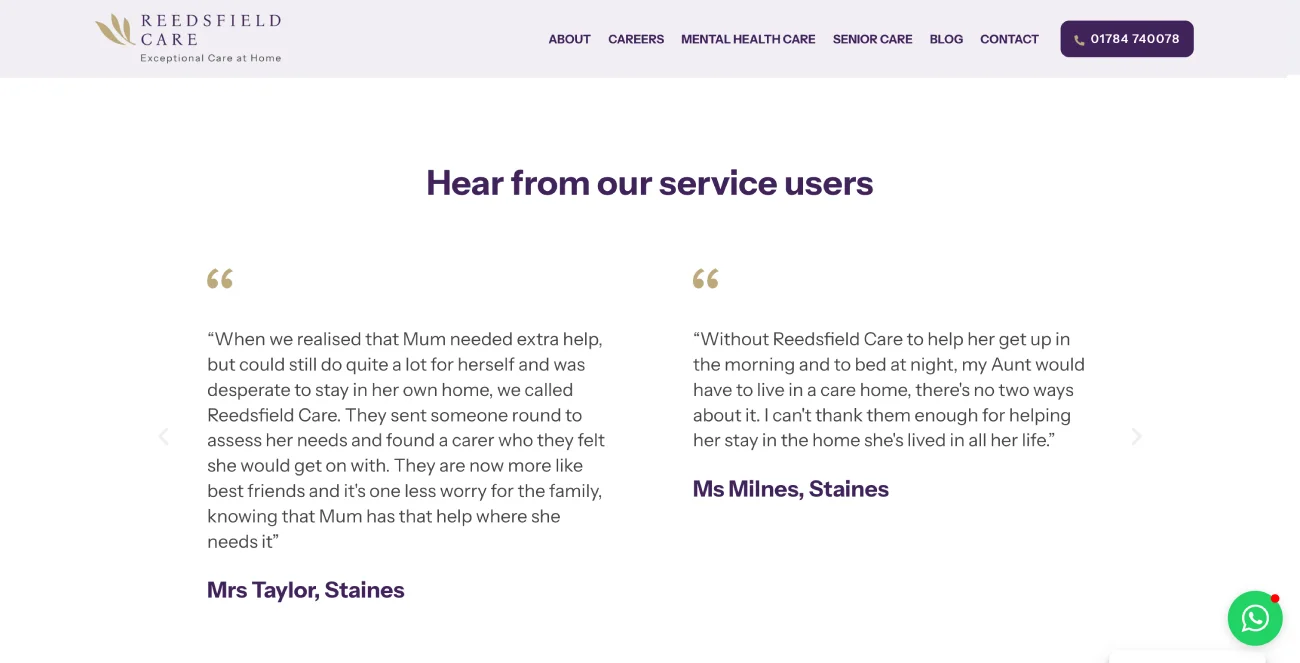When families visit your care website, they’re not just browsing services, they’re looking for reassurance.
They want to know:
- Will my mum be treated with dignity?
- Can I trust these carers to show up on time?
- Do they really care or are they just saying the right things?
These are emotional, high-stakes decisions. And while you may never hear those questions directly, your website is where they begin to form answers.
In this article, we’ll show you how to shape your care website to build trust from the very first visit, not by using more sales language, but by speaking to what families truly need to hear. We’ll also cover common messaging mistakes that can quietly cause hesitation, even when your services are exceptional.
Because in care, the right words don’t just inform, they build confidence.
Ready to build a care website that truly connects?
Book a call with Care Connect and get expert tips on how to speak directly to families’ needs.
Why Trust is Non-Negotiable for Care Providers
Care is personal. Families are looking for someone who will treat their loved one with kindness, dignity and respect. They’re also entrusting you with health, safety and emotional well-being. That makes trust the foundation of every care decision, and your website needs to reflect that from top to bottom.
You don’t get a second chance at a first impression, and if your website doesn’t convey the right message or tone, you risk losing potential clients before they even reach out.

Homepage of a care provider with simple, easy-to-understand services. Reedsfield Care
What to Say to Build Trust on Your Website
Here’s how to write website content that builds confidence and encourages visitors to take the next step.
1. Be Clear About Who You Are and What You Do
Avoid vague or jargon-heavy introductions. Instead, be specific. Say exactly what services you offer, who they’re for and what sets you apart. For example:
- “We provide in-home aged care and disability support services across Leicester, with a focus on respectful, personalised care.”
This kind of clarity positions you as credible and confident, while also helping families instantly know whether you’re the right fit.

Smiling care worker and elderly man at home – real carers, real trust. Image by Freepik
2. Show the Real People Behind the Brand
Adding staff profiles, photos, and short bios communicates transparency and personality. It helps potential clients see that there are warm, qualified people ready to help.
Including a welcome message from your founder or care manager, especially in video format, adds a personal touch and builds rapport.
3. Use Reassuring, Compassionate Language
Tone is everything. Your copy should be warm, calm and empathetic, not cold or sales-focused. Use phrases like:
- “You’re not alone, we’re here to support you every step of the way.”
- “Every person in our care is treated like family.”
These types of messages act as trust signals on a website, showing that you understand what families are going through.
Need help writing trust-building content for your care website?
Download our free Home Care Marketing Blueprint for expert tips on messaging, structure, and creating a site that truly connects.

Client testimonial highlighting a positive care experience from a family member. Reedsfield Care
4. Include Testimonials and Stories
Social proof is one of the strongest website trust signals you can use. Sharing reviews, testimonials, or stories from real clients shows you’ve earned others’ trust, which makes new visitors more likely to trust you, too.
Make sure to include names, photos or videos (with permission), as generic reviews without context can feel fake or overly polished.
5. Make Contact Easy and Welcoming
Clear calls-to-action such as “Book a free consultation” or “Call us to chat” help reduce hesitation. Let visitors know what to expect when they reach out, for example:
- “Speak directly with our care coordinator, who will take the time to understand your situation and explain how we can help.”
Even better: add a photo and the name of the person they’ll be speaking to. These subtle but powerful website trust signals go a long way in making visitors feel safe.
6. Provide Detailed FAQs and Service Information
People visit your website looking for answers. Anticipate their questions by offering clear, informative FAQs that cover pricing, qualifications, service areas and what happens next.
Transparency shows professionalism and signals that you’re not hiding anything, a key factor in how to build trust on your website.
7. Include Third-Party Validation
Accreditations, memberships (e.g., NDIS registration), awards and partnerships are excellent trust signals on a website. Place these in visible spots like the footer, homepage or “About” page. Just make sure they’re up to date and relevant.
What to Avoid Saying on Your Website
Now that we’ve covered what to say, here are common traps to avoid that could undermine your trustworthiness.
1. Overuse of Buzzwords or Sales Language
Words like “best,” “leading,” “affordable” or “premium” without evidence come across as empty claims. Instead of saying you’re “trusted by hundreds,” show proof through real testimonials, case studies or partnerships.
Avoid sounding like a salesperson; you’re offering support and care, not selling a product.
2. Ambiguous or Generic Messaging
Phrases like “high-quality care solutions” don’t mean much unless you explain what that looks like in practice. Be specific. Use concrete examples and paint a picture of the care experience.
3. Long Blocks of Text Without Structure
Even the most helpful content won’t be read if it’s poorly laid out. Break text into short paragraphs, use subheadings and include visuals where possible. A clear layout enhances readability, and great design is part of how to build trust on a website too.
4. Lack of Transparency Around Costs or Process
Not everyone expects a full price list, but vague messaging like “tailored packages available” without a clear next step can seem evasive. Be upfront about how pricing is structured or what to expect in an initial consultation.

5. Outdated Content or Broken Links
These small things send big red flags. If your blog hasn’t been updated in years or your contact form doesn’t work, it suggests neglect, and no one wants to trust a care provider that doesn’t maintain its own site.
Let Your Website Be a Reflection of Your Care
Everything you say (and don’t say) on your website sends a message. The right words and structure help you build credibility and connect with the people you’re best placed to support.
Think of your website as the first step in your care journey with each family. By using clear messaging, compassionate language and strong website trust signals, you show visitors they’re not just browsing a service, they’re finding a partner in care.
When considering how to build trust on your website, always ask: Does this content make the visitor feel understood, supported and safe? If the answer is yes, you’re on the right track.
Need help making a website that people remember? Get in touch with the Care Connect team today!
Want expert help building trust on your care website?
Contact Care Connect to discuss a tailored marketing strategy designed for care providers like you.